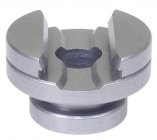When seizing 9mm cases, some of them get stuck on the shell holder (to the top part of it) requiring to be pushed down by hand to cycle the press.
I played with running the APP when I first got one. I was interested in how it would compare to a Dillon when doing nasty case prep on ugly brass with crimped primers or stuff with bad bulges, or full auto use, etc..
At first I used wet/pin tumble to make sure I could get a clean clear view for visual inspection. That worked for getting a good view of the brass, but it also caused problems with operations like sizing. When the brass was "too clean" it caused friction problems and higher forces.
In theory, you may not need lube for straight wall pistol brass when using a carbide die, but lube does reduce the force considerably. When brass is wet/pin tumbled or ultrasonic cleaned, it can create a friction problem, but not always.
Friction is one of those statistical problems, so what you might find working for those other calibers might not work for examples were the forces might get high enough to trigger the problem. It isn't a stead problem and can be just the ones that are bulged, but when it comes and goes it can be frustrating.
I found that tumbling in walnut was a decent compromise to avoid wet tumbling and it also produced lower forces on the dies and it had a positive effect on those hard extraction pulls that minimized rims wanting to jam on the shell holder from being pulled too hard.
Before I found that the walnut tumble had some sort of magic, I played with graphite and other wet lubes. Those lubes required another tumble operation to remove, but they did work very well. I was glad the walnut tumble worked so I avoided the extra steps. I really loath processing pistol cases to screen for crimped or small/large primers, but I learned that if I don't it ruins the work flow.
The APP is a clever machine, but that shell holder that enables it to work fast is not good at anything that takes high forces on the dies, especially the extraction forces since the rim is not well supported.
You may want to look real close at your shell holder and detail any sharp edges and look for burrs. I broke those edges under magnification cause I can't see up close any more without reading glasses. Detailing those edges will help prevent them from digging into the cases when the forces get high.
In general, I think that if the APP is used for sizing, you should consider lube to keep die forces low. If you can play with a recipe that doesn't require a lube and the extra steps to clean that up, then it should reduce the forces to the point where the cases don't jam on that shell holder.











